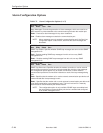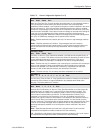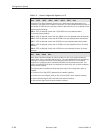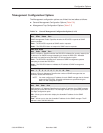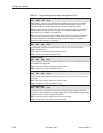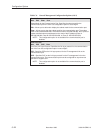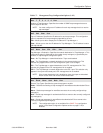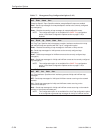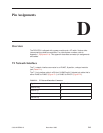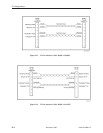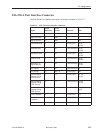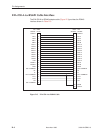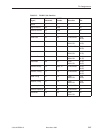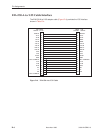
Configuration Options
C-23
3166-A2-GB20-10
November 1998
Table C-7. Management Trap Configuration Options (1 of 2)
Num Trap Mgrs: 1
Next 1 2 3 4 5 6 Prev
Number of Trap Managers. Specifies the number of SNMP trap managers that are to
receive traps for this unit.
NOTE: You must configure an IP address for each trap manager that is to receive
trap messages.
Trap
n
IP Adr:
Next Edit Clear Prev
Trap
n
IP Address. Specifies the IP address for each trap manager. This configuration
option is repeated for all trap managers supported by the unit.
Edit – Allows you to edit or display the IP address for Trap Manager
n
.
Clear – Allows you to clear the IP address for Trap Manager
n
. The IP address is set to
000.000.000.000.
Trap
n
Dst: None
Next None Com FDL EDL1 Prev
Trap Manager
n
Destination. Specifies the network destination for Trap Manager
n
. This
configuration option is displayed for the number of trap managers (
n
) specified by the
Number of Trap Managers configuration option.
None – No Trap Manager
n
network destination. Traps are discarded.
Com – The Trap Manager
n
network destination is the communication port. This
selection only appears if the Com Use configuration option is set to Mgmt.
FDL – The Trap Manager
n
network destination is the FDL management link. This
selection only appears if the FDL management link is enabled.
EDL1 – The Trap Manager
n
network destination is the EDL1 port. This selection only
appears if the synchronous data port’s EDL management link is enabled.
NOTE: If the chosen destination link is disabled or down, the traps are discarded.
Return to this menu and choose another destination.
Gen Trap: Both
Next Disab Warm Auth Both Prev
General Trap Types. Specifies the general trap types to enable.
Disab – Disables the sending of trap messages for warmStart and authenticationFailure
events.
Warm – Sends trap messages for warmStart events to the currently configured trap
manager(s).
Auth – Sends trap messages for authenticationFailure events to the currently configured
trap manager(s).
Both – Sends trap messages for warmStart and authenticationFailure events to the
currently configured trap manager(s).
NOTE: This configuration option is not available if the SNMP Trap configuration
option (in the
Alarm Configuration Options
section on page C-16) is
disabled.




